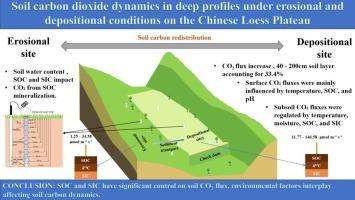黄土高原侵蚀沉积条件下深层剖面土壤二氧化碳动态特征
IF 5.7
1区 农林科学
Q1 GEOSCIENCES, MULTIDISCIPLINARY
引用次数: 0
摘要
土壤侵蚀改变了土壤结构、水文和碳动态,但驱动土壤CO2排放的机制尚不清楚,特别是在高度可蚀性的中国黄土高原。研究了侵蚀和沉积对典型挡土坝0 ~ 200 cm土壤剖面CO2垂直通量的影响及其调控。从2022年6月到10月,我们每月对CO2通量、土壤温度、湿度、物理化学性质和δ13C特征进行测量。土壤有机碳(SOC)总储量在侵蚀点和沉积点之间基本一致,但其垂直分布规律不同:侵蚀点土壤有机碳积累较深,而沉积点土壤有机碳近地表富集。沉积地点较深土层(140 ~ 200 cm)的土壤无机碳(SIC)储量也高于侵蚀地点,这可能是由于碳酸盐聚集所致。沉积样地CO2通量(11.77 ~ 146.58 μmol m-2 s-1)显著高于侵蚀样地(1.25 ~ 34.58 μmol m-2 s-1),其中底土排放占总通量的33.4%。地表CO2通量主要受温度、有机碳和pH的影响,而地下CO2通量主要受温度、湿度、有机碳和碳化硅的影响。δ13C特征表明,在侵蚀部位,有机碳矿化是主要的CO2来源,而在沉积底土中,碳酸盐来源的CO2则占主导地位。这些发现揭示了地貌过程和底土条件在调节CO2排放中的重要作用,为改善侵蚀易发区土壤碳管理提供了科学依据。本文章由计算机程序翻译,如有差异,请以英文原文为准。

Soil carbon dioxide dynamics in deep profiles under erosional and depositional conditions on the Chinese Loess Plateau
Soil erosion alters soil structure, hydrology, and carbon dynamics, yet the mechanisms driving subsoil CO2 emissions are not well understood, particularly in the highly erodible Chinese Loess Plateau. This study investigated the effects of erosion and deposition on vertical CO2 fluxes and associated controls in 0–200 cm soil profiles of representative check dam systems. We conducted monthly measurements of CO2 flux, soil temperature, moisture, physicochemical properties, and δ13C signatures from June to October 2022. Although total soil organic carbon (SOC) stocks were similar between erosional and depositional sites, their vertical patterns differed: SOC exhibited deeper accumulation at erosional sites but was enriched near the surface at depositional sites. Deeper soil layers (140–200 cm) in depositional sites also exhibited higher soil inorganic carbon (SIC) stocks than erosional sites, likely due to carbonate accumulation. CO2 fluxes were significantly higher at depositional sites (11.77 – 146.58 μmol m–2 s–1) than at erosional sites (1.25 – 34.58 μmol m–2 s–1), with subsoil emissions contributing up to 33.4 % of total fluxes. Surface CO2 fluxes were mainly influenced by temperature, SOC, and pH, while subsoil fluxes were regulated by temperature, moisture, SOC, and SIC. δ13C signatures indicated SOC mineralization as the dominant CO2 source at erosional sites, whereas carbonate-derived CO2 was dominant in depositional subsoils. These findings reveal the crucial role of geomorphic processes and subsoil conditions in regulating CO2 emissions and provide a scientific basis for improving soil carbon management in erosion-prone regions.
求助全文
通过发布文献求助,成功后即可免费获取论文全文。
去求助
来源期刊

Catena
环境科学-地球科学综合
CiteScore
10.50
自引率
9.70%
发文量
816
审稿时长
54 days
期刊介绍:
Catena publishes papers describing original field and laboratory investigations and reviews on geoecology and landscape evolution with emphasis on interdisciplinary aspects of soil science, hydrology and geomorphology. It aims to disseminate new knowledge and foster better understanding of the physical environment, of evolutionary sequences that have resulted in past and current landscapes, and of the natural processes that are likely to determine the fate of our terrestrial environment.
Papers within any one of the above topics are welcome provided they are of sufficiently wide interest and relevance.
 求助内容:
求助内容: 应助结果提醒方式:
应助结果提醒方式:


